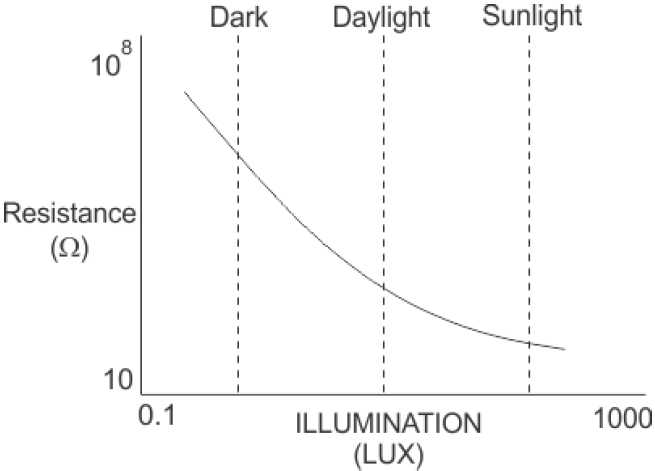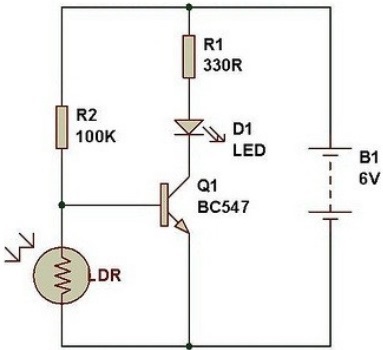LDR or Light Dependent Resistor which is also known as photo resistor is a device whose resistivity is a function of the incident electromagnetic radiation. SO we can say that these are light sensitive devices. Other terms which are used for LDR are photo conductors, photo conductive cells or simply photocells. Light dependent resistor (LDR) or a photoresistor or photocell is a light controlled variable resistor. Its resistance changes with the light intensity that falls on it. The resistance of a photoresistor decreases with increasing incident light intensity. In other words, it exhibits photoconductivity. The resistance range and sensitivity of a photoresistor can substantially differ among dissimilar devices.
If we compare ldr and the photo diode, LDRs are less sensitive than photo diodes and also as compared to photo transistor. A photo diode and a photocell (LDR) are not the same, a photodiode is a p-n junction semiconductor device that converts light to electricity, whereas a photocell is a passive device, there is no p-n junction nor it converts light to electricity.
Construction & Usage of Light Dependent Resistors LDR’s
LDR’s are made up of semiconductor materials having high resistance. Photocells or LDR are non linear devices. The light detection sensitivity of LDR varies with the wavelength of incident light these are exposed to, LDR can be designed to respond to specific intensities of light therefor some photocells might not at all response to a certain range of wavelengths.
LDR’s have minimal effort and straightforward structure. LDR’s are most frequently utilized as light sensors in a lighting control system. Energy conservation has now a days become a primary ficus world wide and in order to turn the lights off when no one is available in a area is very important therefore ldr is used when there is a need to recognize absences or habitations of light like in a cam light meter. Used in street lamps, alarm clock, burglar alarm circuits, light intensity meters, for counting the packages moving on a conveyor belt, etc.
Light Dependent Resistor ldr are made up of semiconductor materials having high resistance. There are many different symbols used to indicate a LDR, one of the most commonly used symbol is shown in the figure below. The arrow indicates light falling on Light Dependent Resistor.
Working Principle Of LDR Light Dependent Resistor
A LDR works on the principle of photo conductivity which is an optical phenomenon in which the materials conductivity reduces when light is absorbed by the material. When light falls on the photocell or LDR the electrons in the valence band of the semiconductor material are excited to the conduction band. In order to get the proper output or response these photons in the incident light should have energy greater than the band gap of the semiconductor material use in LDR to make the electrons jump from the valence band to the conduction band. Until the required intensity of light having enough energy is incident on the device, more and more electrons are excited to the conduction band which results in large number of charge carriers. The result of this process is more and more current starts flowing and hence it is said that the resistance of the device has decreased.

Let’s understand from below example how a light dependent resistor is used in controlling the lighting system i.e as a photocell or photoresistor. So benefits of using LDR in lighting control include energy savings, low cost, safety, security and reducing physical efforts.
Refer below diagram.
Light falls on LDR, it shows its minimum resistance and voltage drops across LDR less than VBE of Transistor Q1. So, no current will go from the collector to the emitter and transistor remains turn off.
No light falls on LDR, it shows its maximum resistance and voltage drops across LDR greater than VBE of Transistor Q1. Now the transistor enters into ON state and at the output side Ic current will flow through the LED. So, the LED is ON.

Types Of LDR Light Dependent Resistor
There are two types of light dependent resistors or LDR’s i.e. intrinsic LDR and extrinsic ldr.
Intrinsic ldr are pure semiconductor materials such as silicon or germanium. In these types of light dependent resistors electrons get excited from valence band to conduction band when photons of enough energy falls on them and number of charge carriers increases.
Extrinsic LDR are semiconductor materials doped with impurities which are called as dopants that create new energy bands above the valence band which are filled with electrons. Hence this reduces the band gap and less energy is required in exciting them. Extrinsic photo resistors are generally used for lights having long wavelengths
Basic Characteristics & Advantages Of LDR Light Dependent Resistor
LDR or light dependent resistor is light dependent device whose resistance decreases when light falls on them and increases in the darkness. When a light dependent resistor is kept in dark, its resistance is very high. This resistance is called as dark resistance and reaches as high as 1012 Ω. On the other hand LDR is allowed to absorb light its resistance will decrease drastically.
If a constant voltage is applied to it and intensity of light is increased the current starts increasing. When light is incident on a LDR photocell it usually takes about 8 to 12ms for the change in resistance to take place, while it takes seconds for the resistance to rise back again to its initial value after removal of light. This phenomenon is called as resistance recovery rate of an LDR or photocell.
LDRs are cheap and are readily available in many sizes, shapes and package styles, the most popular size having a face diameter of roughly 10 mm. LDR need very small power and voltage for its operation. LDR are highly inaccurate when used with a response time of about tens or hundreds of milliseconds.
Discover more from Electrical Engineering 123
Subscribe to get the latest posts sent to your email.
